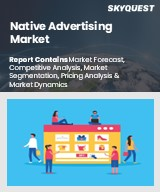
네이티브 광고 세계 시장 규모는 2023년 900억 4,000만 달러, 2024년에는 1,046억 3,000만 달러, 2032년에는 3,468억 6,000만 달러로 성장할 것으로 예측되며, 예측 기간(2025-2032년) CAGR은 16.2%를 나타낼 전망입니다.
세계 네이티브 광고 시장은 비파괴적이고 컨텐츠에 기반한 광고 포맷에 대한 선호도가 높아지면서 크게 성장하고 있습니다. 이러한 추세는 기존의 배너 광고에서 소셜 미디어 피드나 추천 컨텐츠에 게재되어 유기적인 느낌으로 소비자를 끌어들이는 광고로의 전환을 의미합니다. 네이티브 광고는 높은 클릭률을 달성하고, 편집 컨텍스트에 통합되어 신뢰를 형성하는 것으로 알려져 있습니다. 스마트폰의 보급과 모바일 퍼스트 전략으로 인해 시장 도달 범위와 영향력은 더욱 확대되고 있습니다. 그러나 표준화된 측정의 부재, 투명성 및 윤리적 관행에 대한 규제 당국의 감시 강화 등의 과제도 남아있습니다. 이러한 문제들은 특히 민감한 분야에서의 보급을 가로막고 있습니다. 그럼에도 불구하고 네이티브 광고는 브랜드가 소비자의 관심을 끌고 참여를 유도할 수 있는 독특한 기회를 제공합니다.
Global Native Advertising Market size was valued at USD 90.04 Billion in 2023 poised to grow between USD 104.63 Billion in 2024 to USD 346.86 Billion by 2032, growing at a CAGR of 16.2% in the forecast period (2025-2032).
The global native advertising market is experiencing significant growth, propelled by a rising preference for non-disruptive, content-aligned ad formats. This trend signifies a shift from traditional banner ads towards placements in social media feeds and content recommendations, engaging consumers in a manner that feels organic. Native ads are known for achieving higher click-through rates and fostering trust due to their integration within editorial contexts. The proliferation of smartphones and mobile-first strategies has further enhanced the market's reach and impact. However, challenges persist, including the absence of standardized measurement and growing regulatory scrutiny regarding transparency and ethical practices. These issues hinder widespread adoption, particularly in sensitive sectors. Nevertheless, native advertising presents brands with unique opportunities to effectively capture consumer attention and drive engagement.
Top-down and bottom-up approaches were used to estimate and validate the size of the Global Native Advertising market and to estimate the size of various other dependent submarkets. The research methodology used to estimate the market size includes the following details: The key players in the market were identified through secondary research, and their market shares in the respective regions were determined through primary and secondary research. This entire procedure includes the study of the annual and financial reports of the top market players and extensive interviews for key insights from industry leaders such as CEOs, VPs, directors, and marketing executives. All percentage shares split, and breakdowns were determined using secondary sources and verified through Primary sources. All possible parameters that affect the markets covered in this research study have been accounted for, viewed in extensive detail, verified through primary research, and analyzed to get the final quantitative and qualitative data.
Global Native Advertising Market Segments Analysis
The global native advertising market is segmented based on Ad format, industry vertical, platform type, and region. In terms of Ad format, the market is divided into In-feed ads, content recommendation widgets, sponsored articles, and custom content units. Based on industry vertical, the market is bifurcated into media & entertainment, retail & e-commerce, BFSI, and healthcare & wellness. Based on platform type, the market is grouped into Desktop, Mobile, Tablet, and Cross-Platform. Based on region, the market is segmented into North America, Europe, Asia-Pacific, Latin America and the Middle East and Africa.
Driver of the Global Native Advertising Market
A significant factor driving the growth of the global native advertising market is the widespread shift towards content-focused marketing strategies. Brands are increasingly exploring formats that integrate seamlessly with editorial content, enhancing consumer engagement and building trust while reducing ad fatigue and the phenomenon of banner blindness. This transition transforms brand advertisements from mere interruptions into valuable content that resonates with users. Such trends are particularly prominent in sectors like e-commerce and finance, where providing educational content empowers consumers and opens avenues for improved conversion rates. Overall, this approach illustrates a profound change in how brands connect with their audiences effectively.
Restraints in the Global Native Advertising Market
One significant challenge facing the global native advertising market is the absence of standardized measurement metrics and disclosure regulations. This inconsistency leads advertisers and publishers to use diverse tracking methods, which can restrict the ability to evaluate campaign effectiveness comprehensively across different platforms. Furthermore, the indistinct distinction between editorial and sponsored content raises concerns among critics regarding transparency, which hinders trust and slows adoption within regulated markets. Without clearly defined rules and reliable metrics, the potential for native advertising to thrive and prove its impact remains constrained, presenting challenges for stakeholders aiming to maximize the effectiveness of their campaigns.
Market Trends of the Global Native Advertising Market
The Global Native Advertising market is witnessing a significant trend towards privacy-first contextual targeting, driven by the phasing out of third-party cookies and increasing regulatory clarity worldwide. As advertisers prioritize compliance, native advertising formats are gaining traction for their ability to integrate seamlessly with editorial content. Companies are heavily investing in AI-powered contextual engines that classify content in real time without depending on individual user data. This technological advancement is spurring innovation within the ad-tech industry and enhancing user trust, particularly in highly regulated markets such as the EU and Canada, aligning with the future growth expectations of the native advertising landscape.